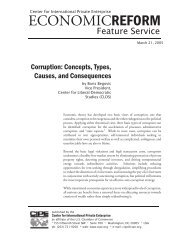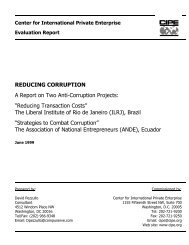Responsible Business Guide: A Toolkit for Winning Companies
Responsible Business Guide: A Toolkit for Winning Companies
Responsible Business Guide: A Toolkit for Winning Companies
Create successful ePaper yourself
Turn your PDF publications into a flip-book with our unique Google optimized e-Paper software.
RBG<br />
<strong>Responsible</strong> <strong>Business</strong> <strong>Guide</strong>: A <strong>Toolkit</strong> <strong>for</strong> <strong>Winning</strong> <strong>Companies</strong><br />
Apart from regulations, companies themselves exercise internal controls against<br />
mismanagement, typically in the <strong>for</strong>m of rules and regulations, standard operating procedures,<br />
and limits to authority manuals. Company hierarchies are another accountability mechanism.<br />
Externally, there are more and more independent watchdog bodies, including government<br />
agencies like the Competition Commission of Pakistan, trade unions, and non-governmental<br />
organizations like Transparency International or Consumer International, often with national<br />
affiliates, keeping track of company decisions and their impacts.<br />
In today’s consumer-driven environment, the market itself is assuming the role of a corporate<br />
accountability mechanism. Aware consumers are making buying decisions as large, wellconnected<br />
groups. For example, the threat of a boycott of Danish goods in Muslim countries<br />
caused immediate diplomatic action by the Danish government to mitigate the threat.<br />
Fifteen years ago, the threat of a ban on Pakistani footballs in a World Cup year brought<br />
the global football industry to rally behind local producers, helping them tackle issues<br />
surrounding child labor.<br />
Equally as important as accountability is transparency, which implies that a company’s<br />
owners or managers will not only assume responsibility <strong>for</strong> their decisions but will<br />
communicate their reasons openly within and outside the company to stakeholders. For<br />
companies, transparency implies direct, open communication between company decisionmakers<br />
and key stakeholders such as employees, shareholders, and consumers. The annual<br />
general meeting of shareholders is a regulatory instrument to implement transparency and<br />
accountability. Other common ways are through websites, company newsletters and media<br />
messages, and increasingly advertising. Taken together, these two concepts manifest the<br />
measure of a company’s governance.<br />
<strong>Responsible</strong> <strong>Business</strong> Initiative 25

















